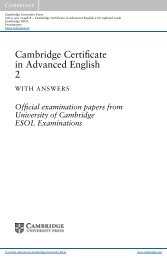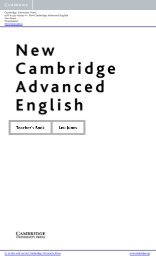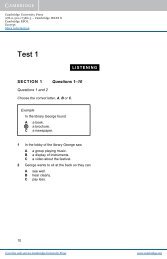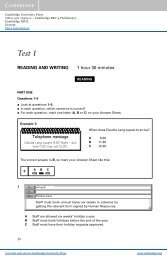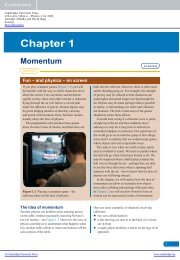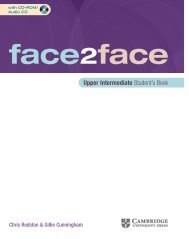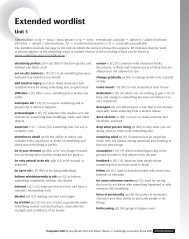Skills for Study Level 2 Teacher's Book - Cambridge University Press
Skills for Study Level 2 Teacher's Book - Cambridge University Press
Skills for Study Level 2 Teacher's Book - Cambridge University Press
You also want an ePaper? Increase the reach of your titles
YUMPU automatically turns print PDFs into web optimized ePapers that Google loves.
1iSuggested answers (based on this in<strong>for</strong>mation)• 52% of students were women in 2000 and 54% by 2005.• 26% of engineering degrees are awarded to women, whereas 66% of arts andhumanities degrees and 76% of all education degrees go to female students.• The number of senior academic staff who are women is very low, comparedto the number of men.• A little over 10% of all professors are women, and <strong>for</strong> senior lecturers it’s justover 30%.• The percentage of graduates who are women was under 50% in the 1980s,and it’s well over half of all students now and predicted to keep rising (onaverage among OECD countries).• In the UK, it’s predicted to keep growing until 70% of all students in the UKare female, and so the numbers of women graduating with degrees will risetoo, over the next 25 years.1 T2 T3 T4 This is uncertain from the in<strong>for</strong>mation given, particularly as the statementabove says ‘probably’. This is intended to get students to discuss their ownideas, and use their own interpretations of Anna’s claims and in<strong>for</strong>mation tosupport their viewpoint.1j Group discussion2 Understanding references to graphic data2aSuggested answersa1 Bar chart2 Proportion of PhD graduates who are female in different fields3 Overall percentage; relatively low numbers of female engineering,manufacturing and construction PhD graduates.b1 Table2 Proportion of senior academic staff who are female3 Particularly low totals overall; particularly low total in Germany; relatively lowpercentage in the 55+ age group.c1 Pie chart2 Proportion of women in top-level academic positions3 Huge discrepancy between top-level male and female academics.d1 Table2 Female PhD researchers by field3 Relatively low numbers of female engineering, manufacturing andconstruction PhD researchers; relatively higher numbers of female educationand humanities graduates; largest growth between 2001 and 2006: education;smallest growth between 2001 and 2006: humanities and arts.e1 Pie chart2 Higher education students by level of study3 Big difference between percentages of full-time and part-time undergraduates;small difference between percentages of full-time and part-time postgraduates.Unit 1 Part A ∙ Understanding spoken in<strong>for</strong>mation 10



